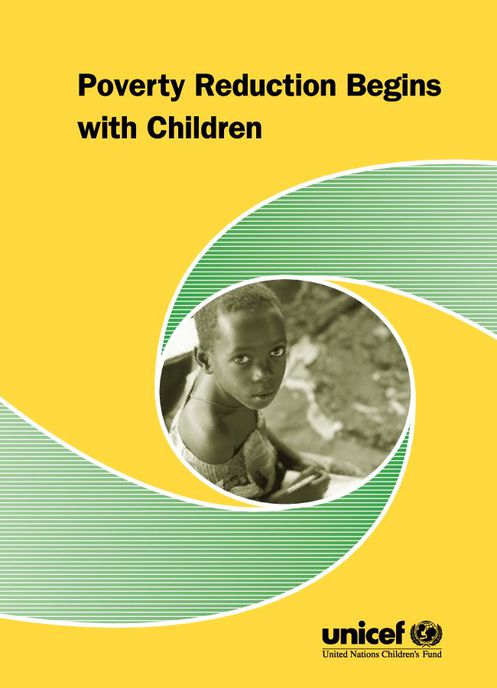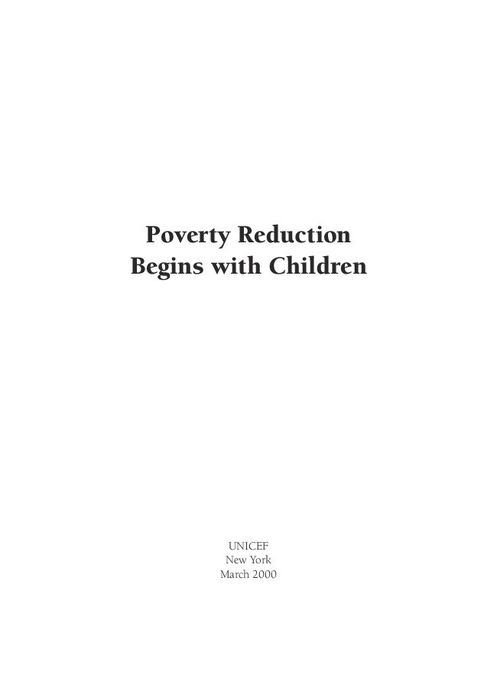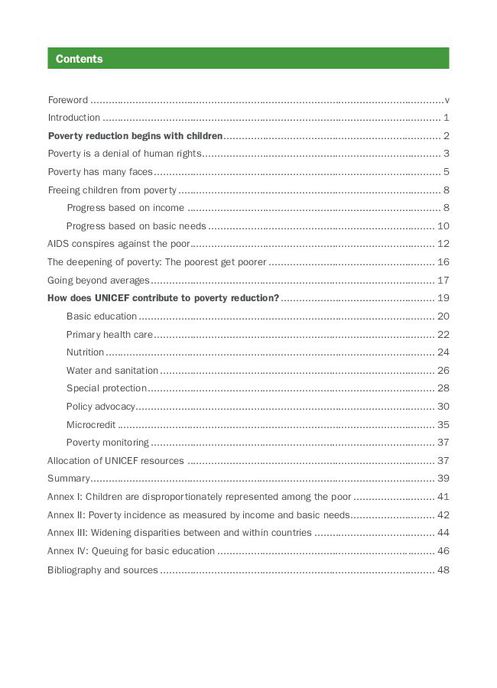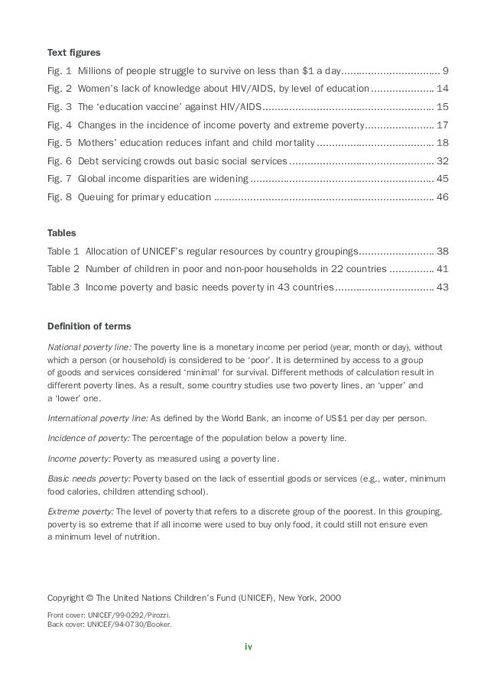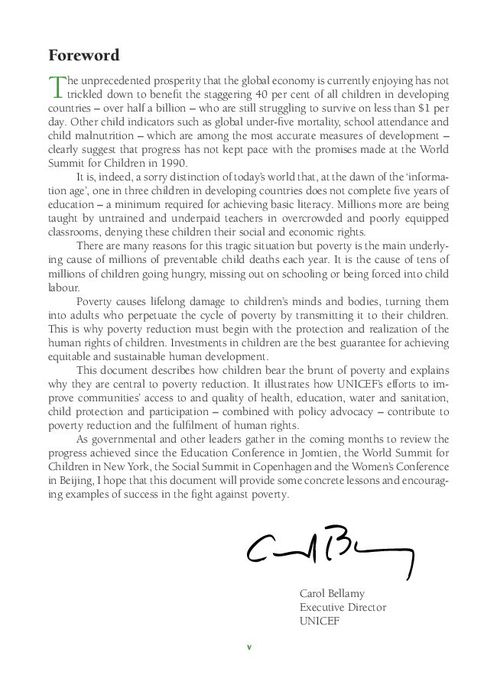Poverty reduction begins with children
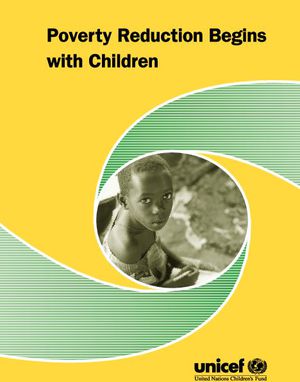
Vista previa
Se requiere el inicio de sesión
Usted debe ser miembro de la comunidad ForChildren.com para descargar recursos. ¡Haga clic en los botones de abajo para iniciar sesión o registrarse!
| Categoría | Protección del niño |
The unprecedented prosperity that the global economy is currently enjoying has not trickled down to benefit the staggering 40 per cent of all children in developing countries – over half a billion – who are still struggling to survive on less than $1 per day. Other child indicators such as global under-five mortality, school attendance and child malnutrition – which are among the most accurate measures of development – clearly suggest that progress has not kept pace with the promises made at the World Summit for Children in 1990. It is, indeed, a sorry distinction of today’s world that, at the dawn of the ‘information age’, one in three children in developing countries does not complete five years of education – a minimum required for achieving basic literacy. Millions more are being taught by untrained and underpaid teachers in overcrowded and poorly equipped classrooms, denying these children their social and economic rights. There are many reasons for this tragic situation but poverty is the main underlying cause of millions of preventable child deaths each year. It is the cause of tens of millions of children going hungry, missing out on schooling or being forced into child labour. Poverty causes lifelong damage to children’s minds and bodies, turning them into adults who perpetuate the cycle of poverty by transmitting it to their children. This is why poverty reduction must begin with the protection and realization of the human rights of children. Investments in children are the best guarantee for achieving equitable and sustainable human development. This document describes how children bear the brunt of poverty and explains why they are central to poverty reduction. It illustrates how UNICEF’s efforts to improve communities’ access to and quality of health, education, water and sanitation, child protection and participation – combined with policy advocacy – contribute to poverty reduction and the fulfilment of human rights. As governmental and other leaders gather in the coming months to review the progress achieved since the Education Conference in Jomtien, the World Summit for Children in New York, the Social Summit in Copenhagen and the Women’s Conference in Beijing, I hope that this document will provide some concrete lessons and encouraging examples of success in the fight against poverty
Documentos relacionados
-
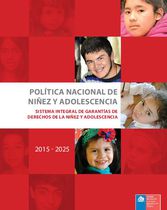
Política nacional de niñez y adolescencia
Proyecto 2015-2025 del Consejo Nacional de la Infancia en Chile -
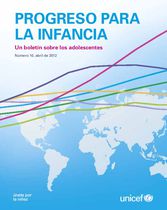
PROGRESO PARA LA INFANCIA Un boletín sobre los adolescentes Número 10, abril de 2012
Los boletines de calificaciones de los adolescentes del mundo constituyen la medida de sus logros académicos y pueden señalarles el cam… -
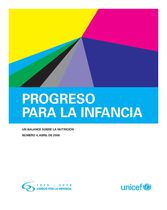
PROGRESO PARA LA INFANCIA UN BALANCE SOBRE LA NUTRICIÓN NÚMERO 4, ABRIL DE 2006
Erradicar la pobreza extrema y el hambre, reducir la mortalidad infantil y alcanzar los Objetivos de Desarrollo del Milenio (ODM) relativos a la salu… -
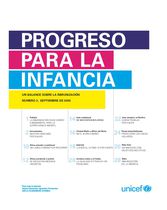
Progreso para la infancia un balance sobre la inmunización número 3
Al mundo le quedan solamente 10 años para cumplir con la promesa realizada en la Declaración del Milenio y plasmada en los Objetivos de… -
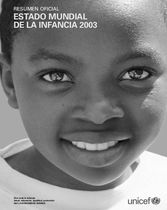
RESUMEN OFICIAL ESTADO MUNDIAL DE LA INFANCIA 2003
El Estado Mundial de la Infancia 2003 se refiere a la participación infantil. Se centra en la responsabilidad de los adultos de " tratar de ob… -
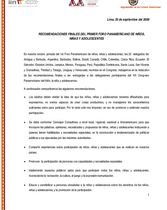
RECOMENDACIONES FINALES DEL PRIMER FORO PANAMERICANO DE NIÑOS, NIÑAS Y ADOLESCENTES
En nuestra tercera jornada del 1er Foro Panamericano de niños, niñas y adolescentes, los 22 delegados de: Antigua y Barbuda, Argentina,… -
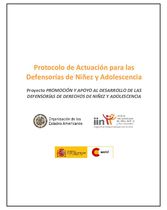
Protocolo de Actuación para las Defensorías de Niñez y Adolescencia Proyecto PROMOCIÓN Y APOYO …
El desafío de la defensa y promoción de los Derechos Humanos de la Niñez en realidad tiene una historia reciente en el derecho i… -
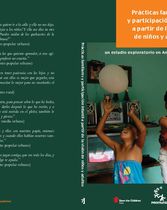
Prácticas familiares y participación infantil a partir de la visión de niños y adultos
Prácticas familiares y participa - ción infantil a partir de la visión de niños y adultos: un estudio exploratorio en Am&… -
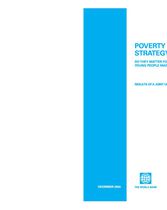
Poverty Reduction. Strategy Papers.
It is widely agreed that HIV/AIDS should be prominent in the Poverty Reduction Strategy Papers (PRSPs) of African countries in light of the challenge… -
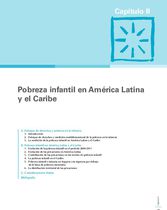
Pobreza infantil en América Latina y el Caribe
En la segunda década del siglo XXI, la pobreza sigue representando un desafío de enorme magnitud para los países de Améri…
ForChildren.com, presentado por Compassion International, ofrece ideas, oportunidades de aprendizaje y relaciones para ayudar a equipar a las personas que trabajan con niños en situación de riesgo. Somos una comunidad mundial de seguidores de Jesús comprometidos con el desarrollo integral de los niños. Lo invitamos a que se una a nosotros como comunidad colaborativa para compartir con otros las ideas, experiencias, métodos y herramientas que ayuden a los niños a triunfar incluso en la peor de las adversidades.
ForChildren.com es presentado por Compassion International, una organización 501(c)3 registrada sin fines de lucro. Todos los recursos, los cursos y las discusiones son para propósitos educativos únicamente, no para lucrar.





